The Cambridge History of China. Vol. 13: Republican China 1912-1949, Part 2
Подождите немного. Документ загружается.

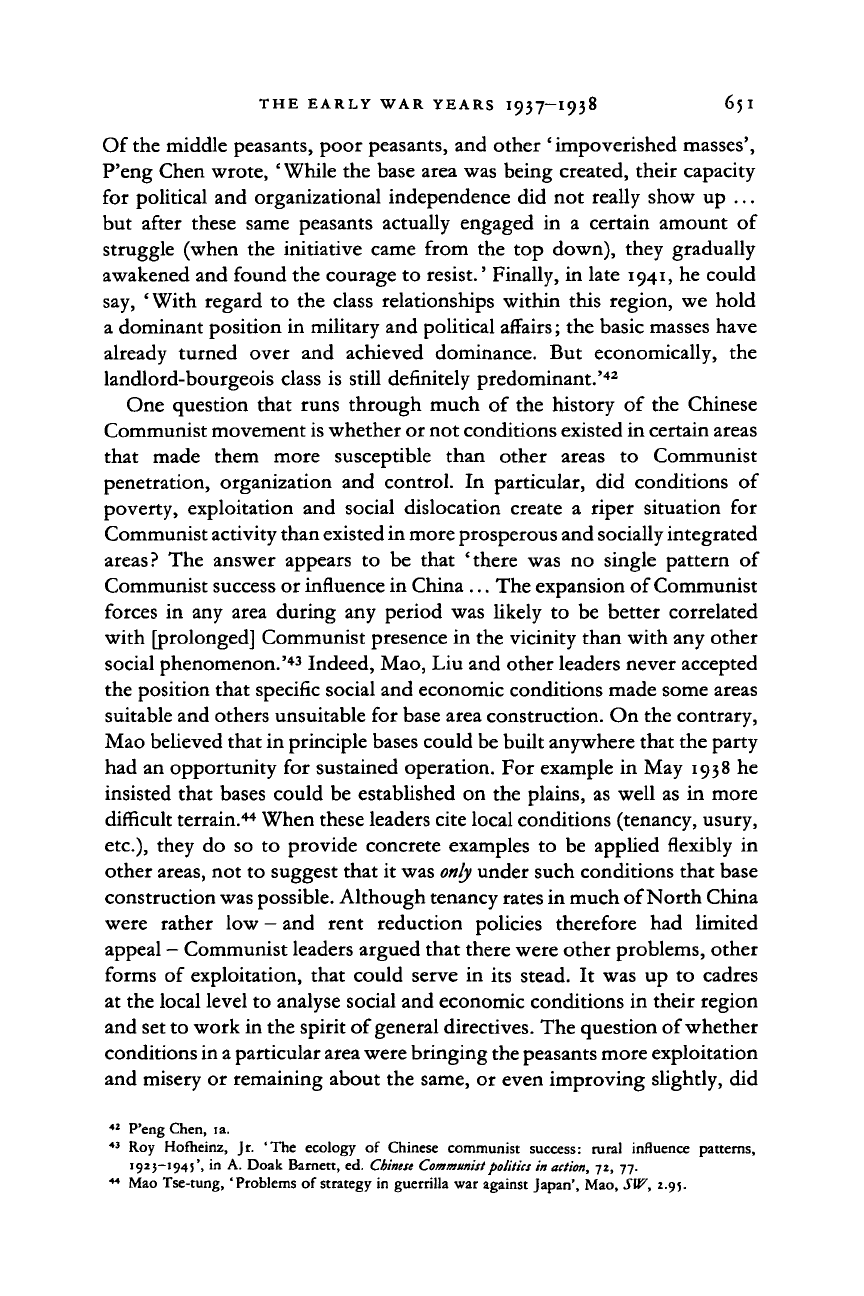
THE EARLY WAR YEARS I937-I938 65 I
Of the middle peasants, poor peasants, and other 'impoverished masses',
P'eng Chen wrote, ' While the base area was being created, their capacity
for political and organizational independence did not really show up
...
but after these same peasants actually engaged
in a
certain amount
of
struggle (when the initiative came from the top down), they gradually
awakened and found the courage to resist.' Finally, in late
1941,
he could
say, 'With regard
to
the class relationships within this region, we hold
a dominant position in military and political affairs; the basic masses have
already turned over
and
achieved dominance.
But
economically,
the
landlord-bourgeois class is still definitely predominant.'
42
One question that runs through much
of
the history
of
the Chinese
Communist movement is whether or not conditions existed in certain areas
that made them more susceptible than other areas
to
Communist
penetration, organization and control.
In
particular,
did
conditions
of
poverty, exploitation and social dislocation create
a
riper situation
for
Communist activity than existed in more prosperous and socially integrated
areas? The answer appears
to be
that 'there was
no
single pattern
of
Communist success or influence in China ... The expansion of Communist
forces
in
any area during any period was likely
to be
better correlated
with [prolonged] Communist presence in the vicinity than with any other
social phenomenon.'
43
Indeed, Mao, Liu and other leaders never accepted
the position that specific social and economic conditions made some areas
suitable and others unsuitable for base area construction. On the contrary,
Mao believed that in principle bases could be built anywhere that the party
had an opportunity for sustained operation. For example in May 1938 he
insisted that bases could be established on the plains, as well as
in
more
difficult terrain.
44
When these leaders cite local conditions (tenancy, usury,
etc.),
they do so
to
provide concrete examples
to be
applied flexibly
in
other areas, not to suggest that it was
only
under such conditions that base
construction was possible. Although tenancy rates in much of North China
were rather low
-
and rent reduction policies therefore
had
limited
appeal
—
Communist leaders argued that there were other problems, other
forms
of
exploitation, that could serve
in
its stead.
It
was up
to
cadres
at the local level to analyse social and economic conditions in their region
and set to work in the spirit of general directives. The question of whether
conditions in
a
particular area were bringing the peasants more exploitation
and misery or remaining about the same, or even improving slightly, did
42
P'eng Chen,
ia.
43
Roy
Hoflieinz,
Jr.
"The
ecology
of
Chinese communist success: rural influence patterns,
1923-1945',
in A.
Doak Barnett, ed. Chinese Communist politics
in
action, 72,
77.
44
Mao Tse-tung, 'Problems
of
strategy
in
guerrilla
war
against Japan', Mao,
SW, 2.9;.
Cambridge Histories Online © Cambridge University Press, 2008
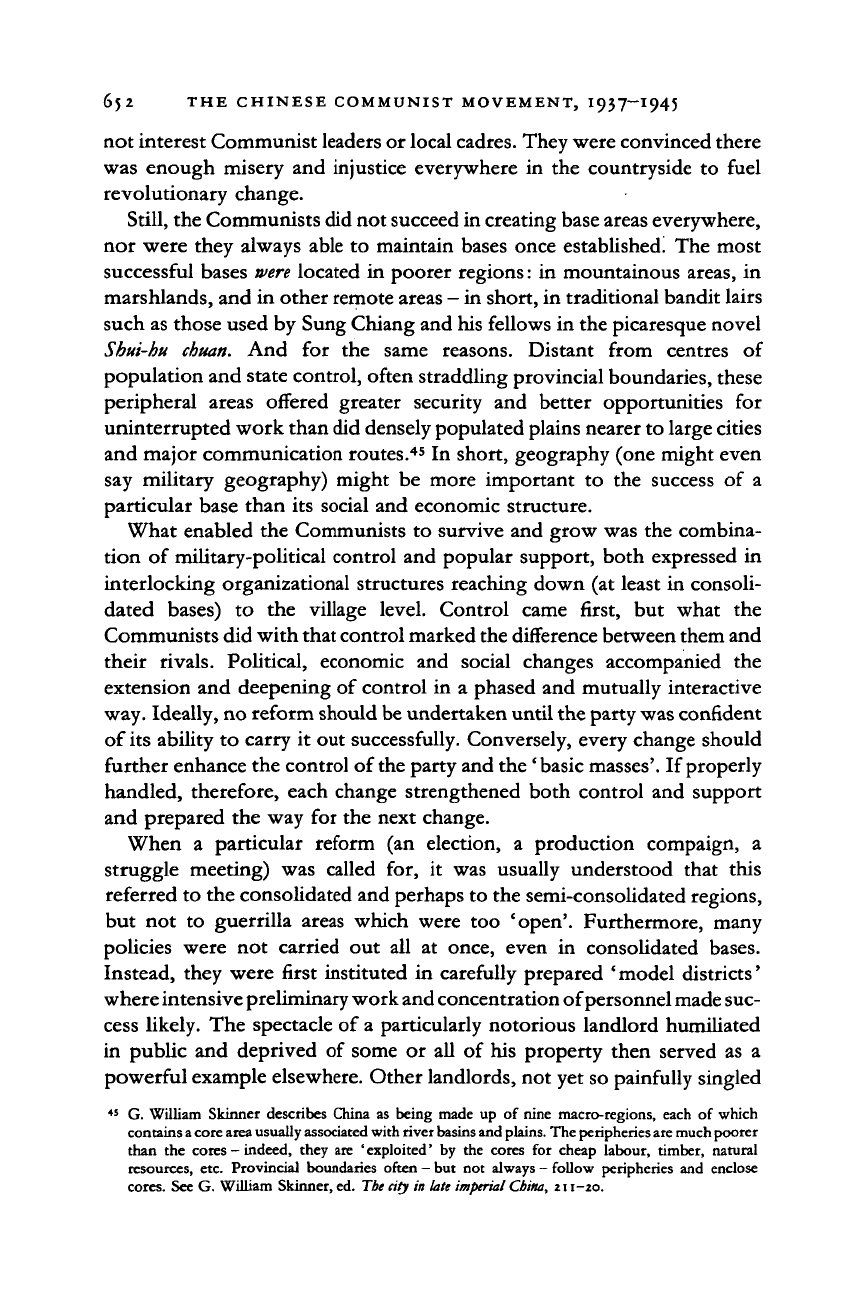
652 THE CHINESE COMMUNIST MOVEMENT, I937-I945
not interest Communist leaders or local cadres. They were convinced there
was enough misery and injustice everywhere
in
the countryside
to
fuel
revolutionary change.
Still, the Communists did not succeed in creating base areas everywhere,
nor were they always able to maintain bases once established. The most
successful bases
were
located in poorer regions: in mountainous areas,
in
marshlands, and in other remote areas
-
in short, in traditional bandit lairs
such as those used by Sung Chiang and his fellows in the picaresque novel
Sbui-hu chuan.
And for the
same reasons. Distant from centres
of
population and state control, often straddling provincial boundaries, these
peripheral areas offered greater security
and
better opportunities
for
uninterrupted work than did densely populated plains nearer to large cities
and major communication routes.
45
In short, geography (one might even
say military geography) might
be
more important
to the
success
of a
particular base than its social and economic structure.
What enabled the Communists to survive and grow was the combina-
tion
of
military-political control and popular support, both expressed
in
interlocking organizational structures reaching down (at least in consoli-
dated bases)
to the
village level. Control came first,
but
what
the
Communists did with that control marked the difference between them and
their rivals. Political, economic
and
social changes accompanied
the
extension and deepening of control in
a
phased and mutually interactive
way. Ideally, no reform should be undertaken until the party was confident
of its ability to carry
it
out successfully. Conversely, every change should
further enhance the control of
the
party and the '
basic
masses'. If properly
handled, therefore, each change strengthened both control and support
and prepared the way for the next change.
When
a
particular reform
(an
election,
a
production compaign,
a
struggle meeting) was called
for, it
was usually understood that this
referred to the consolidated and perhaps to the semi-consolidated regions,
but
not to
guerrilla areas which were too 'open'. Furthermore, many
policies were
not
carried
out all at
once, even
in
consolidated bases.
Instead, they were first instituted
in
carefully prepared ' model districts'
where intensive preliminary work and concentration of personnel made suc-
cess likely. The spectacle of a particularly notorious landlord humiliated
in public and deprived
of
some
or
all
of
his property then served as
a
powerful example elsewhere. Other landlords, not yet so painfully singled
45
G. William Skinner describes China
as
being made up
of
nine macro-regions, each
of
which
contains
a
core area usually associated with river basins and
plains.
The peripheries are much poorer
than
the
cores
-
indeed, they are 'exploited'
by
the cores
for
cheap labour, timber, natural
resources,
etc.
Provincial boundaries often
-
but
not
always
-
follow peripheries and enclose
cores.
See G. William Skinner, ed. The
city
in
late imperial
China,
211-20.
Cambridge Histories Online © Cambridge University Press, 2008
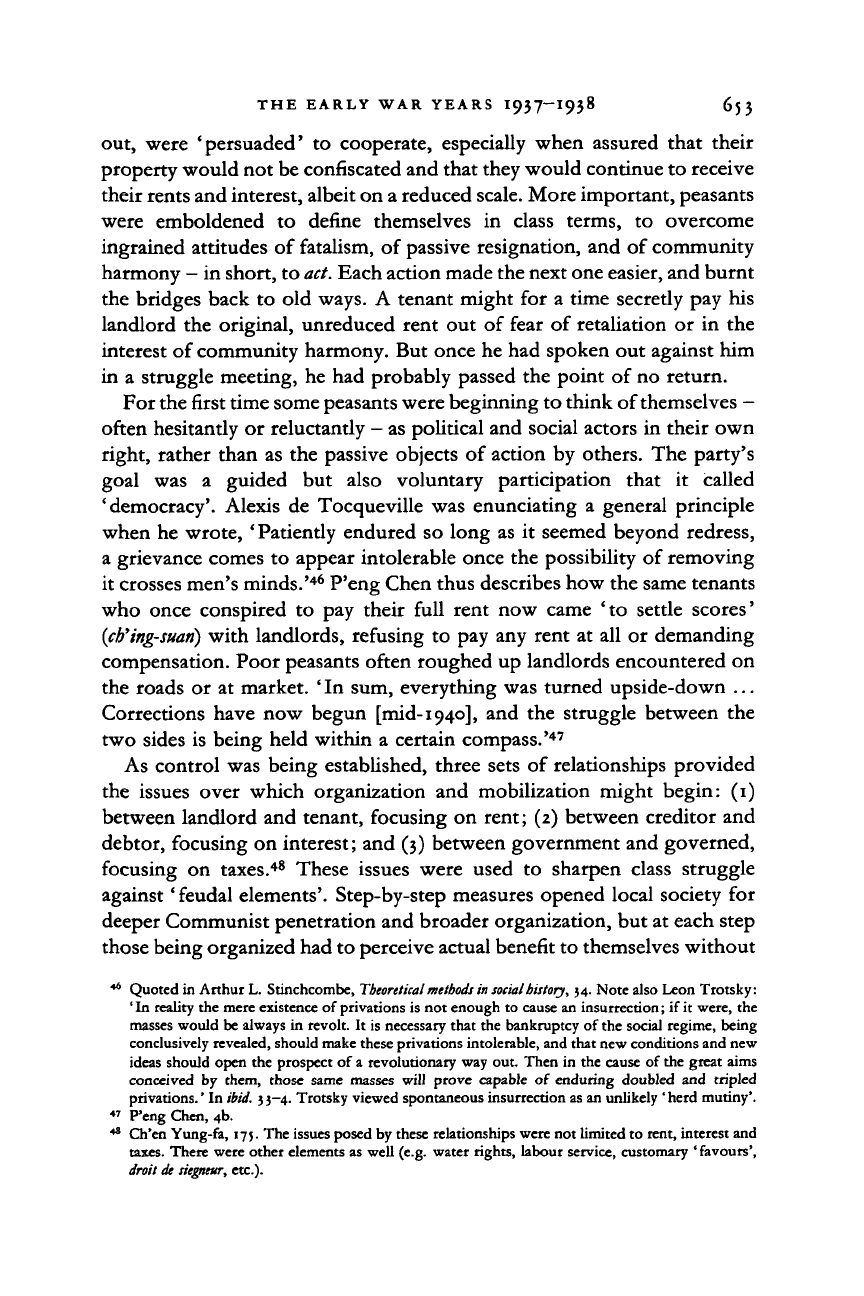
THE EARLY WAR YEARS I937-I938 653
out, were 'persuaded'
to
cooperate, especially when assured that their
property would not be confiscated and that they would continue to receive
their rents and interest, albeit on a reduced scale. More important, peasants
were emboldened
to
define themselves
in
class terms,
to
overcome
ingrained attitudes of fatalism, of passive resignation, and of community
harmony
-
in short, to
act.
Each action made the next one easier, and burnt
the bridges back to old ways.
A
tenant might for
a
time secretly pay his
landlord the original, unreduced rent out
of
fear
of
retaliation
or in
the
interest of community harmony. But once he had spoken out against him
in
a
struggle meeting, he had probably passed the point
of
no return.
For the first time some peasants were beginning to think of themselves
-
often hesitantly or reluctantly
-
as political and social actors in their own
right, rather than as the passive objects
of
action by others. The party's
goal
was a
guided
but
also voluntary participation that
it
called
'democracy'. Alexis
de
Tocqueville was enunciating
a
general principle
when he wrote, 'Patiently endured so long as
it
seemed beyond redress,
a grievance comes to appear intolerable once the possibility of removing
it crosses men's minds.'
46
P'eng Chen thus describes how the same tenants
who once conspired
to
pay their full rent now came
'to
settle scores'
(ch'ing-suan)
with landlords, refusing
to
pay any rent
at
all
or
demanding
compensation. Poor peasants often roughed up landlords encountered on
the roads
or
at market. ' In sum, everything was turned upside-down
...
Corrections have now begun [mid-1940], and the struggle between
the
two sides is being held within
a
certain compass.'
47
As control was being established, three sets
of
relationships provided
the issues over which organization
and
mobilization might begin:
(1)
between landlord and tenant, focusing on rent; (2) between creditor and
debtor, focusing on interest; and (3) between government and governed,
focusing
on
taxes.
48
These issues were used
to
sharpen class struggle
against' feudal elements'. Step-by-step measures opened local society
for
deeper Communist penetration and broader organization, but at each step
those being organized had to perceive actual benefit to themselves without
46
Quoted
in
Arthur L. Stinchcombe, Theoretical methods in social history, 34. Note also Leon Trotsky:
'
In reality the mere existence
of
privations
is
not enough
to
cause
an
insurrection;
if
it were,
the
masses would
be
always
in
revolt.
It is
necessary that the bankruptcy
of
the social regime, being
conclusively revealed, should make these privations intolerable, and that new conditions and new
ideas should open the prospect
of a
revolutionary way out. Then
in the
cause
of
the great aims
conceived
by
them, those same masses will prove capable
of
enduring doubled
and
tripled
privations.'
In
ibid.
3
3-4. Trotsky viewed spontaneous insurrection as
an
unlikely
'
herd mutiny'.
47
P'eng Chen, 4b.
48
Ch'en Yung-fa, 175. The issues posed by these relationships were not limited
to
rent, interest and
taxes. There were other elements
as
well (e.g. water rights, labour service, customary
'
favours',
droit de sitgntur, etc.).
Cambridge Histories Online © Cambridge University Press, 2008
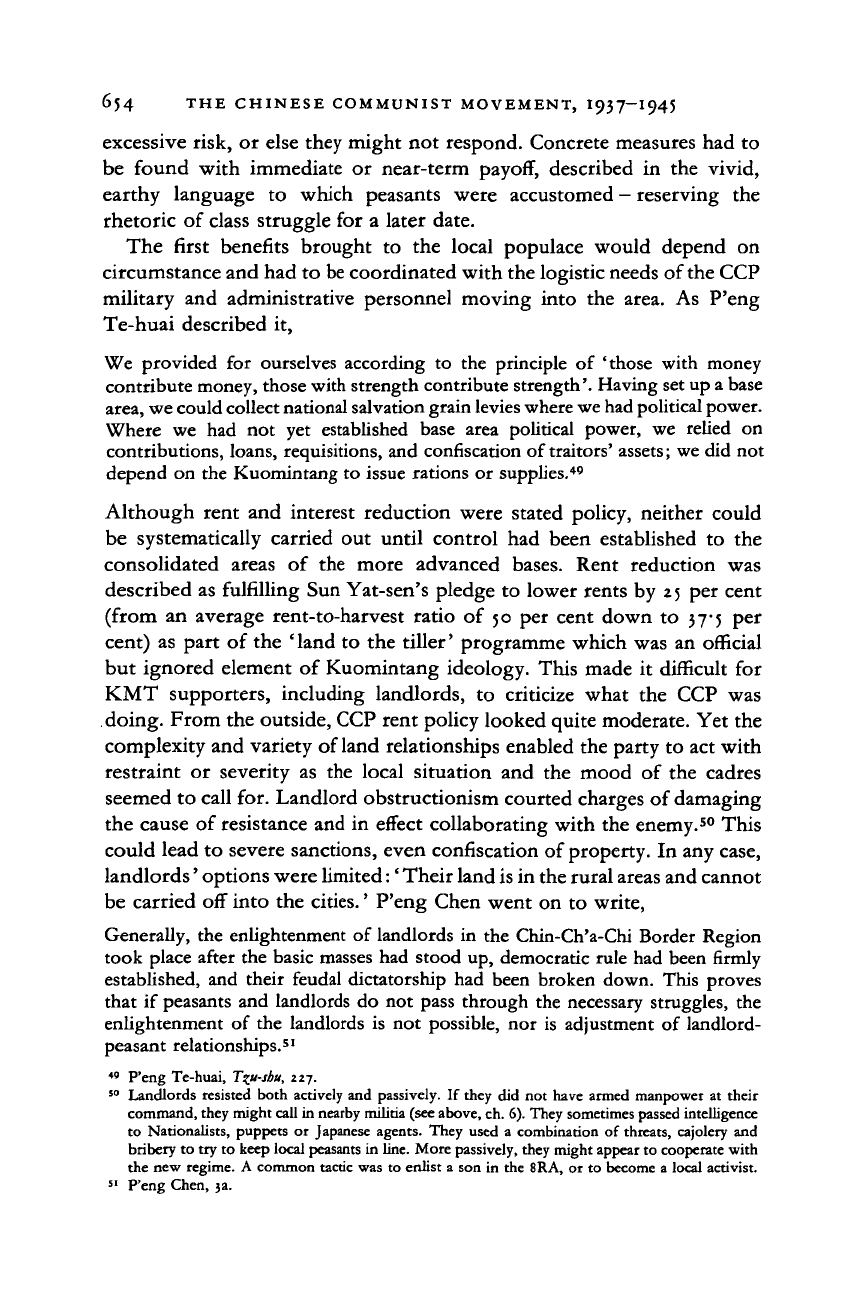
654 THE CHINESE COMMUNIST MOVEMENT, I937-I945
excessive risk, or else they might not respond. Concrete measures had to
be found with immediate
or
near-term
payoff,
described
in
the vivid,
earthy language
to
which peasants were accustomed
—
reserving
the
rhetoric of class struggle for
a
later date.
The first benefits brought
to the
local populace would depend
on
circumstance and had to be coordinated with the logistic needs of the CCP
military and administrative personnel moving into the area.
As
P'eng
Te-huai described
it,
We provided
for
ourselves according
to
the principle
of
'those with money
contribute money, those with strength contribute strength'. Having set up
a
base
area, we could collect national salvation grain
levies where
we had
political power.
Where we had
not yet
established base area political power, we relied
on
contributions, loans, requisitions, and confiscation of
traitors'
assets; we did not
depend on the Kuomintang to issue rations or supplies.
49
Although rent and interest reduction were stated policy, neither could
be systematically carried out until control had been established
to the
consolidated areas
of
the more advanced bases. Rent reduction was
described as fulfilling Sun Yat-sen's pledge to lower rents by 25 per cent
(from an average rent-to-harvest ratio
of
50 per cent down
to
37-5
per
cent) as part of the 'land to the tiller' programme which was an official
but ignored element of Kuomintang ideology. This made
it
difficult for
KMT supporters, including landlords,
to
criticize what the CCP was
doing. From the outside, CCP rent policy looked quite moderate. Yet the
complexity and variety of land relationships enabled the party to act with
restraint
or
severity
as
the local situation and the mood
of
the cadres
seemed to call for. Landlord obstructionism courted charges of damaging
the cause of resistance and in effect collaborating with the enemy.
50
This
could lead to severe sanctions, even confiscation of property. In any case,
landlords' options were limited:' Their land is in the rural areas and cannot
be carried off into the cities.' P'eng Chen went on to write,
Generally, the enlightenment of landlords in the Chin-Ch'a-Chi Border Region
took place after the basic masses had stood up, democratic rule had been firmly
established, and their feudal dictatorship had been broken down. This proves
that
if
peasants and landlords do not pass through the necessary struggles, the
enlightenment of the landlords is not possible, nor is adjustment of landlord-
peasant relationships.
51
45
P'eng Te-huai,
T^u-sbu,
227.
50
Landlords resisted both actively
and
passively.
If
they
did not
have armed manpower
at
their
command, they might call
in
nearby militia (see above, ch. 6). They sometimes passed intelligence
to Nationalists, puppets
or
Japanese agents. They used
a
combination
of
threats, cajolery
and
bribery
to
try
to
keep local peasants
in
line. More passively, they might appear
to
cooperate with
the new regime.
A
common tactic was
to
enlist
a son in the
8RA,
or to
become
a
local activist.
51
P'eng Chen, 3 a.
Cambridge Histories Online © Cambridge University Press, 2008
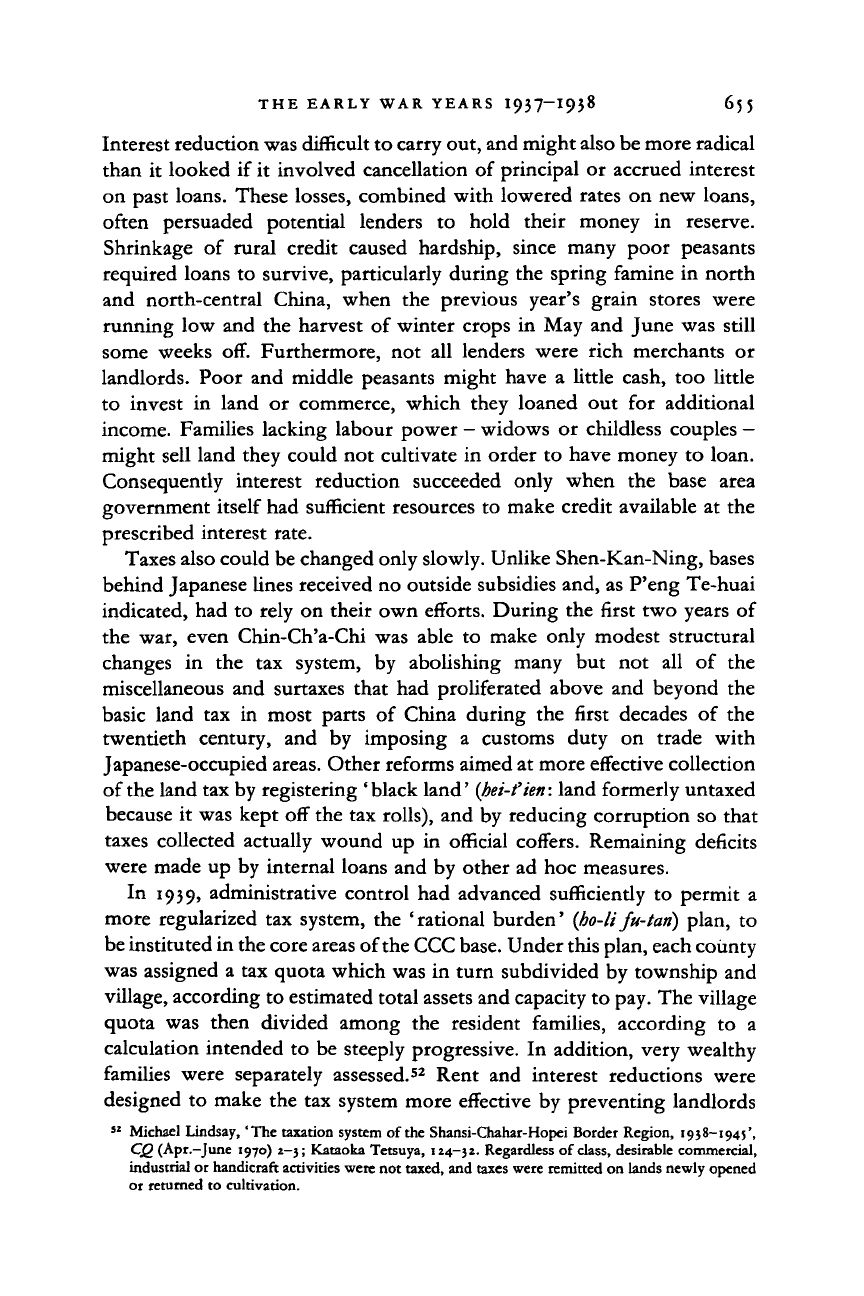
THE EARLY WAR YEARS I937-I938 655
Interest reduction was difficult to carry out, and might also be more radical
than it looked if it involved cancellation of principal or accrued interest
on past loans. These losses, combined with lowered rates on new loans,
often persuaded potential lenders to hold their money in reserve.
Shrinkage of rural credit caused hardship, since many poor peasants
required loans to survive, particularly during the spring famine in north
and north-central China, when the previous year's grain stores were
running low and the harvest of winter crops in May and June was still
some weeks off. Furthermore, not all lenders were rich merchants or
landlords. Poor and middle peasants might have a little cash, too little
to invest in land or commerce, which they loaned out for additional
income. Families lacking labour power
—
widows or childless couples
—
might sell land they could not cultivate in order to have money to loan.
Consequently interest reduction succeeded only when the base area
government itself had sufficient resources to make credit available at the
prescribed interest rate.
Taxes also could be changed only slowly. Unlike Shen-Kan-Ning, bases
behind Japanese lines received no outside subsidies and, as P'eng Te-huai
indicated, had to rely on their own efforts. During the first two years of
the war, even Chin-Ch'a-Chi was able to make only modest structural
changes in the tax system, by abolishing many but not all of the
miscellaneous and surtaxes that had proliferated above and beyond the
basic land tax in most parts of China during the first decades of the
twentieth century, and by imposing a customs duty on trade with
Japanese-occupied areas. Other reforms aimed at more effective collection
of the land tax by registering 'black land'
(hei-fien:
land formerly untaxed
because it was kept off the tax rolls), and by reducing corruption so that
taxes collected actually wound up in official coffers. Remaining deficits
were made up by internal loans and by other ad hoc measures.
In 1939, administrative control had advanced sufficiently to permit a
more regularized tax system, the 'rational burden' {ho-lifu-tan) plan, to
be
instituted in the core areas of the CCC
base.
Under this plan, each county
was assigned a tax quota which was in turn subdivided by township and
village, according to estimated total assets and capacity to pay. The village
quota was then divided among the resident families, according to a
calculation intended to be steeply progressive. In addition, very wealthy
families were separately assessed.
52
Rent and interest reductions were
designed to make the tax system more effective by preventing landlords
S2
Michael Lindsay, 'The taxation system of the Shansi-Chahar-Hopei Border Region, 1938—1945',
CJ2
(Apr.-June 1970) 2-5; Kataoka Tetsuya, 124-52. Regardless of
class,
desirable commercial,
industrial or handicraft activities were not taxed, and taxes were remitted on lands newly opened
or returned to cultivation.
Cambridge Histories Online © Cambridge University Press, 2008

656 THE CHINESE COMMUNIST MOVEMENT, I937-I945
and rich peasants from recouping their
tax
payments
by
passing them
on
to tenants
and
debtors. Clearly, this system could
not
work unless
its
authors had confidence in those who would have
to
carry
it
out
at
county
and village levels. P'eng Chen's report notes that
it was not
until well
into
1939
that
CCC
was able
to
certify
or
replace village heads,
set up
village representative councils,
and
create
a
unified administrative
system
—
and even then only
in
consolidated areas.
53
The rational burden
tax
system
was
used, somewhat later,
in
similar
form
in
other bases,
as
was the second major change,
a
shift from money
to grain
as the
main unit
of
fiscal calculation.
In
CCC,
the
government
kept
its
main accounts
in
units
of
millet,
or
their equivalent. Salaries
and
tax quotas were thus separated from currency fluctuations. Cadres
and
other functionaries were
on a
supply system,
and
received only
the
most
meagre pocket-money income. Troops
or
others travelling
on
official
business were issued grain coupons
(iiang-p'iao),
which they could
exchange
for
grain anywhere within base area jurisdiction. When a village
paid
its tax
quota,
it
could deliver either grain
or
coupons,
or a
mixture
of the two. Since villages were responsible
for
transporting their tax grain
to
the
collection depot, they preferred
the
convenience
of
the coupons.
54
When Communist cadres
and
village leaders chose, they could impose
confiscations, levies, contributions,
and
rational-burden taxes
in
such
a
way that particular individuals
or
categories of local residents experienced
pronounced changes
in
their economic condition. This worked
to the
advantage
of
tenants, poor peasants,
and
middle peasants,
and to the
disadvantage
of
rich peasants
and
landlords, especially
the
latter.
One
scholar claimed that
the 'tax
and rent reduction program
of
the CCP was
revolutionary.
It
amounted
to
confiscation
by
instalment.
>5S
Although this assessment may be correct
for
certain villages
in
the core
areas
of
Chin-Ch'a-Chi,
it
overstates what happened elsewhere
in CCC
and
in
other bases.
By its own
admission,
the
CCP lacked
the
capacity
to carry
out
these policies throughout
the
base areas. Even where such
radical transformation
was
within their power,
the
Communists usually
settled
for
somewhat less,
so
long as
it
deepened their control
and
helped
mobilize peasant support. For one thing, landlords and rich peasants were
the most productive
and
economically effective operators
on the
rural
scene,
if
not through their own direct labour then because
of
their access
to capital, draft animals, tools, know-how,
and
understanding
of
market
conditions. Moreover
the
class demarcations
the
CCP used
as
shorthand
represented only very crudely the more complex reality
in
which peasants
53
P'eng Chen, 9b.
M
Lindsay, 'Taxation system",
3. »
Kataoka Tetsuya, 129-32.
Cambridge Histories Online © Cambridge University Press, 2008
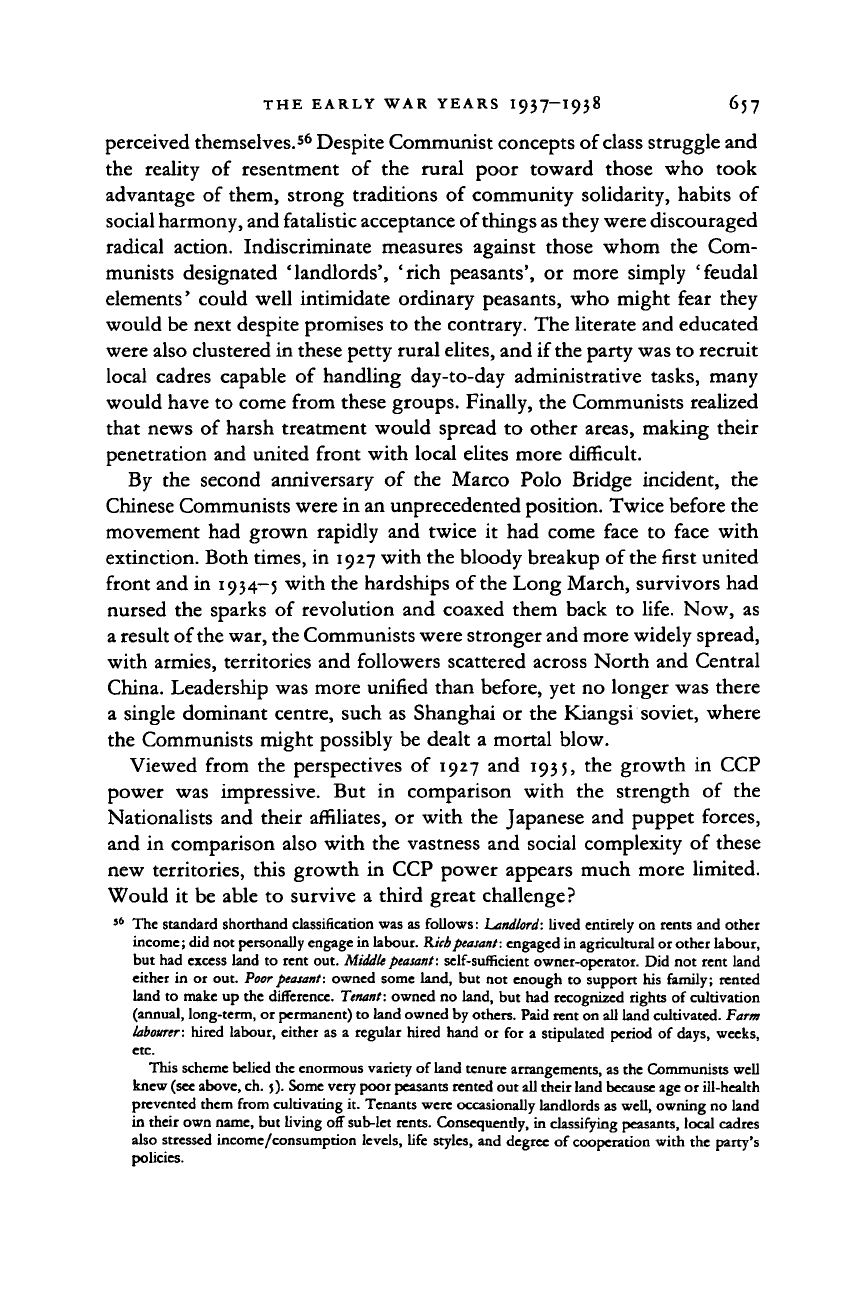
THE EARLY WAR YEARS I937-I938 657
perceived themselves.
56
Despite Communist concepts of class struggle and
the reality of resentment of the rural poor toward those who took
advantage of them, strong traditions of community solidarity, habits of
social harmony, and fatalistic acceptance of things as they were discouraged
radical action. Indiscriminate measures against those whom the Com-
munists designated 'landlords', 'rich peasants', or more simply 'feudal
elements' could well intimidate ordinary peasants, who might fear they
would be next despite promises to the contrary. The literate and educated
were also clustered in these petty rural elites, and if the party was to recruit
local cadres capable of handling day-to-day administrative tasks, many
would have to come from these groups. Finally, the Communists realized
that news of harsh treatment would spread to other areas, making their
penetration and united front with local elites more difficult.
By the second anniversary of the Marco Polo Bridge incident, the
Chinese Communists were in an unprecedented position. Twice before the
movement had grown rapidly and twice it had come face to face with
extinction. Both times, in 1927 with the bloody breakup of the first united
front and in 1934—5 with the hardships of the Long March, survivors had
nursed the sparks of revolution and coaxed them back to life. Now, as
a result of the war, the Communists were stronger and more widely spread,
with armies, territories and followers scattered across North and Central
China. Leadership was more unified than before, yet no longer was there
a single dominant centre, such as Shanghai or the Kiangsi soviet, where
the Communists might possibly be dealt a mortal blow.
Viewed from the perspectives of 1927 and 1935, the growth in CCP
power was impressive. But in comparison with the strength of the
Nationalists and their affiliates, or with the Japanese and puppet forces,
and in comparison also with the vastness and social complexity of these
new territories, this growth in CCP power appears much more limited.
Would it be able to survive a third great challenge?
36
The standard shorthand classification was as follows:
Landlord:
lived entirely on rents and other
income; did not personally engage in labour. Kick
peasant:
engaged in agricultural or other labour,
but had excess land to rent out.
Middle
peasant:
self-sufficient owner-operator. Did not rent land
either in or out.
Poor
peasant:
owned some land, but not enough to support his family; rented
land to make up the difference.
Tenant:
owned no land, but had recognized rights of cultivation
(annual, long-term, or permanent) to land owned by others. Paid rent on all land cultivated. Farm
labourer:
hired labour, either as a regular hired hand or for a stipulated period of days, weeks,
etc.
This scheme belied the enormous variety of
land
tenure arrangements, as the Communists well
knew (see above, ch. 5). Some very poor peasants rented out all their land because age or ill-health
prevented them from cultivating it. Tenants were occasionally landlords as well, owning no land
in their own name, but living off sub-let rents. Consequently, in classifying peasants, local cadres
also stressed income/consumption levels, life styles, and degree of cooperation with the party's
policies.
Cambridge Histories Online © Cambridge University Press, 2008

658 THE CHINESE COMMUNIST MOVEMENT, I937—1945
II.
THE MIDDLE YEARS 1939-1943
Transition to the second phase of the war began in early 1939, as the result
of the stalemate foreseen by Mao
at
the sixth plenum
in
late 1938. Mao
had predicted that during this protracted
'new
stage'
the
forces
of
resistance (meaning principally,
of
course, Communist-led forces) would
grow stronger.
In
reality the balance sheet was mixed.
In
Shantung and
in Central China, new bases came into being, but in much of North China
territory, manpower and population were lost to Japanese consolidation.
Base area economies faced severe problems and
the
peasantry suffered
more intensely than
at
any other time.
Stalemate
had two
dimensions.
The
first
was
growing Nationalist
resentment over Communist expansion, which contrasted
so
strikingly
with their own losses. While the Nationalists were being driven out of the
regions
of
their greatest wealth
and
power
in the
central
and
lower
Yangtze basin, losing the cream
of
their armies
in
the process, the CCP
was seeping into the broad countryside behind Japanese lines, extending
its influence over territory and gaining popular support.
The second dimension was the Japanese desire
-
and need
-
to consoli-
date the territories they had nominally conquered, and to derive economic
benefit from them. After all, the rationale for the China incident was
to
use China's labour and resources
to
augment Japanese strength, not
to
drain its treasure away in China's vast territories.
'Why, oh why,' lamented a Japanese colonel, ' didn't we cut the China
Incident short, after we had attained our initial objectives? It was senseless
of us
to
get lured into the hinterland... All we ever ended up with was
real estate, not popular support from those we "liberated"... We bogged
down, deeper and ever deeper, in that endless morass of attrition.'" The
Japanese authorities
—
still divided and competing among themselves
—
sought to improve their situation in several ways. A new peace offensive
was aimed
at
Chiang Kai-shek simultaneously with efforts
to set up a
' reformed' Nationalist government under Wang Ching-wei, who had fled
Chungking
in
December 1938. More collaborators
and
puppets were
recruited. Finally, the Japanese undertook forceful military, political and
economic measures
to
establish territorial control
and
eliminate
opposition.
57
Quoted in Alvin D. Coox and Hilary Conroy, eds.
China
and
Japan:
a search for
balance since
World
War I, 305.
Cambridge Histories Online © Cambridge University Press, 2008

THE MIDDLE YEARS I939-1943 659
'FRICTION' WITH THE NATIONALISTS
The Communists used the euphemism ' friction'
{mo-ts'a)
to describe their
conflicts with the Nationalists during the middle years of the war. By 1939,
what had appeared to many observers - perhaps erroneously - as an
unexpectedly cordial entente began to fade. In early 1939, the KMT
Central Committee adopted a series of measures to restrict the CCP.
58
Military clashes began in the summer and continued into the autumn and
winter with growing frequency and intensity, most of them taking place
in and around the North China bases. The Communists called the period
between December 1939 and March 1940 'the first anti-Communist
upsurge'. Of course, each side called the other the aggressor, and claimed
self-defence against unwarranted attack. But strategically this north China
'upsurge' was a Nationalist effort to check the unauthorized expansion
of the CCP beyond the areas assigned to them and to regain influence
in areas already lost to the Communists or the Japanese. Chiang Kai-shek
spoke as a traditionalist insisting on his legal rights, while the Communists
insisted on their evolutionary right to question the moral value of the
government's legal rights.
During 1939, the Nationalists began to blockade Shen-Kan-Ning all
around its southern and western perimeter. Within a year, this blockade
numbered nearly 400,000 troops, including some of the best remaining
Central Armies under the overall command of Hu Tsung-nan. The
blockade halted further Communist expansion, particularly in Kansu and
Suiyuan, and it ended direct contact between SKN and Communists active
in Sinkiang (Chinese Turkestan), adjacent to Soviet Central Asia. The
Sinkiang Communists, including Mao Tse-tung's brother, were liquidated
in 1942. Sharp fighting broke out on the Kansu-Shensi border and in the
north-east corner of SKN along the Great Wall near Suite, as the
blockading forces probed for soft spots. Elements of Ho Lung's 120th
Division had to be called back from the Chin-sui base across the Yellow
River to beef up SKN's regular garrison.
Economically, the blockade was even more serious. The central
government's subsidy to the Border Region budget was cut off during
1939.
Trade between the Border Region and other parts of China was
brought to a near standstill, a serious blow to a region unable to supply
itself with many basic commodities.
Nationalist and regional forces also sought to intrude their military and
s8
These were (a) 'Measures to restrict the activities of other parties', (b) 'Measures to deal with
the Communist problem', and (c) 'Measures for guarding against Communist activities in
Japanese-occupied areas'. See Van Slyke, Enemies and friends, 97.
Cambridge Histories Online © Cambridge University Press, 2008
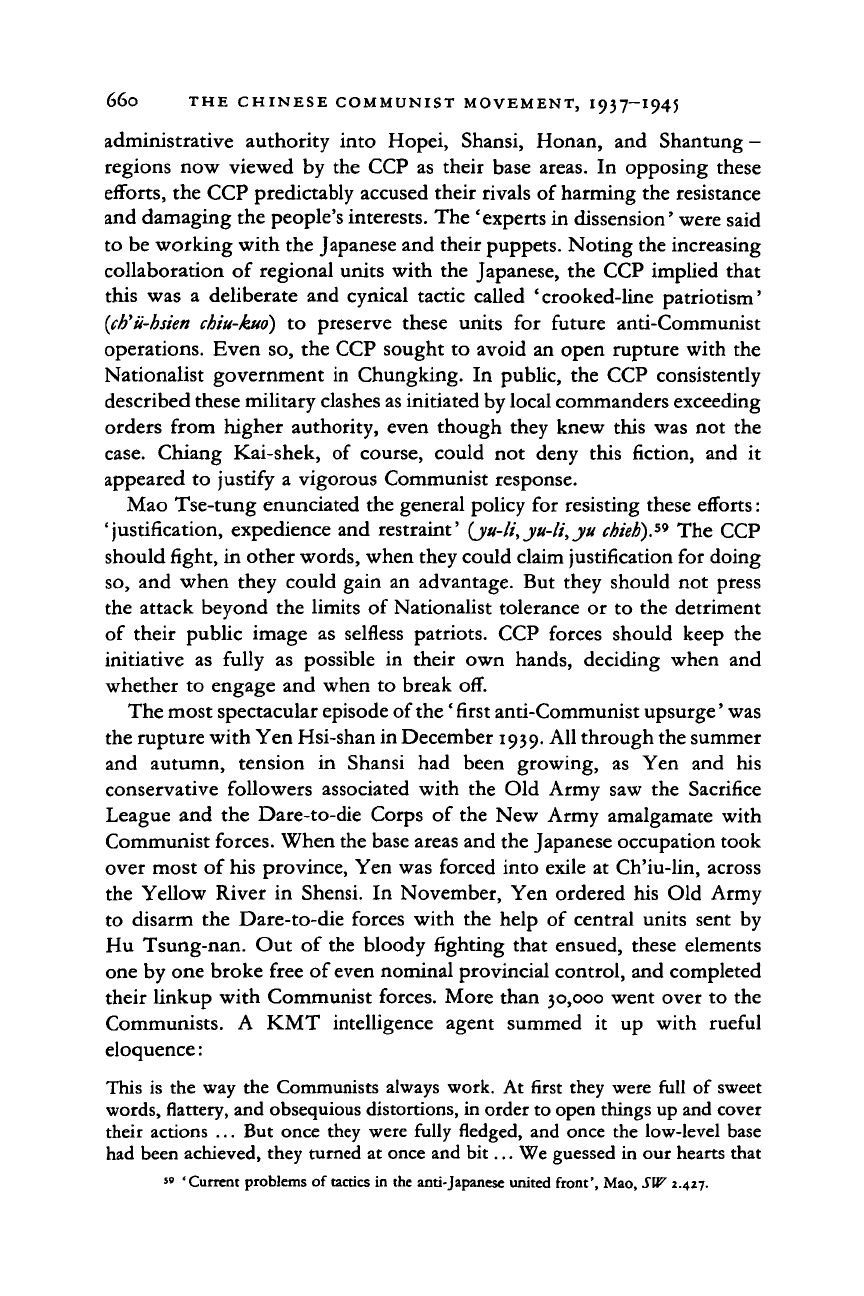
660 THE CHINESE COMMUNIST MOVEMENT, I937—1945
administrative authority into Hopei, Shansi, Honan,
and
Shantung
-
regions
now
viewed
by the
CCP
as
their base areas.
In
opposing these
efforts,
the
CCP predictably accused their rivals
of
harming the resistance
and damaging the people's interests. The 'experts
in
dissension' were said
to
be
working with the Japanese and their puppets. Noting the increasing
collaboration
of
regional units with
the
Japanese,
the
CCP implied that
this
was a
deliberate
and
cynical tactic called 'crooked-line patriotism'
(cb'ii-hsien chiu-kud)
to
preserve these units
for
future anti-Communist
operations. Even
so, the
CCP sought
to
avoid
an
open rupture with
the
Nationalist government
in
Chungking.
In
public,
the CCP
consistently
described these military clashes as initiated by local commanders exceeding
orders from higher authority, even though they knew this
was not the
case.
Chiang Kai-shek,
of
course, could
not
deny this fiction,
and it
appeared
to
justify
a
vigorous Communist response.
Mao Tse-tung enunciated the general policy
for
resisting these efforts:
'justification, expedience
and
restraint' {ju-li,ju-li,ju
chieh).
l<>
The CCP
should fight,
in
other words, when they could claim justification
for
doing
so,
and
when they could gain
an
advantage.
But
they should
not
press
the attack beyond
the
limits
of
Nationalist tolerance
or to the
detriment
of their public image
as
selfless patriots.
CCP
forces should keep
the
initiative
as
fully
as
possible
in
their
own
hands, deciding when
and
whether
to
engage
and
when
to
break
off.
The most spectacular episode of
the'
first anti-Communist upsurge' was
the rupture with Yen Hsi-shan in December 1939. All through the summer
and autumn, tension
in
Shansi
had
been growing,
as Yen and his
conservative followers associated with
the Old
Army
saw the
Sacrifice
League
and the
Dare-to-die Corps
of the New
Army amalgamate with
Communist forces. When the base areas and the Japanese occupation took
over most
of
his province,
Yen
was forced into exile
at
Ch'iu-lin, across
the Yellow River
in
Shensi.
In
November,
Yen
ordered
his Old
Army
to disarm
the
Dare-to-die forces with
the
help
of
central units sent
by
Hu Tsung-nan.
Out of
the bloody fighting that ensued, these elements
one
by
one broke free
of
even nominal provincial control, and completed
their linkup with Communist forces. More than 30,000 went over
to the
Communists.
A KMT
intelligence agent summed
it up
with rueful
eloquence:
This
is the
way
the
Communists always work.
At
first they were full
of
sweet
words,
flattery,
and obsequious distortions, in order to open things up and cover
their actions
... But
once they were fully fledged,
and
once
the
low-level base
had been achieved, they turned
at
once and bit... We guessed in our hearts that
*• 'Current problems
of
tactics
in
the anti-Japanese united front', Mao,
SW
2.427.
Cambridge Histories Online © Cambridge University Press, 2008
